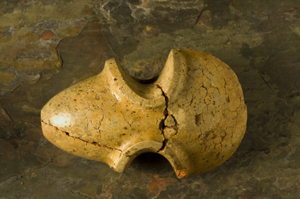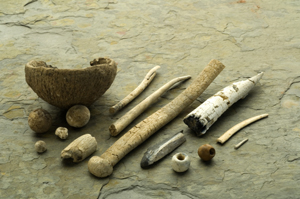Posted: 03 March 2006
Excavation findings from 3500 BC passage tomb at the Mound of the Hostages, Tara published
Human bones, the stark remains of hundreds of people plus a rich assemblage of artefacts were excavated from the Mound of the Hostages, Tara during archaeological excavations in the 1950’s. The findings ranging from about 3500 BC were catalogued and stored at the UCD School of Archaeology. And there they have rested, undisturbed for nearly 50 years, until Dr Muiris O’Sullivan and publisher Nick Maxwell (Wordwell Ltd.) took the initiative to share this treasure trove from the oldest visible monument on the Hill of Tara.

Early Bronze Age battle-axe (c.1800 BC). From the Mound of the Hostages, Hill of Tara.
The battle-axe made from stone, was found with cremated human bones underneath an upturned urn and has been vitrified by the heat.
The first sod of the excavation at the Mound of the Hostages was turned by Seán P. Ó Ríordáin, UCD Professor of Celtic Archaeology in the summer of 1955. His team discovered that the mound was in fact a mantle of soil about 1 metre deep which covered a cairn enclosing a passage tomb. The following year, in 1956 the team began excavating the fill in the outer part of the tomb. They had established that the mound was surrounded by a ring of fire pits and distinctive cremation burials. But tragedy struck that autumn: Professor Ó Ríordáin was diagnosed with a serious illness and died.
‘Ruaidhrí de Valera, Ó Ríordáin’s successor as Professor of Celtic Archaeology at UCD, directed the final season of excavation at the mound in 1959’ says Dr O’Sullivan. ‘The cairn and the tomb capstones were removed and the mass of human bone and other material in the tomb proved to be an incredibly complex stratigraphy to record. Outside the walls of the tomb lay three cists. These cists contained the remains of 55 adults, three children and four infants - more individuals than most excavated megalithic tombs have produced in total.’
‘But the main tomb proved to be even more remarkable’ tells Dr O’Sullivan. ‘It housed the richest collection of Neolithic and early Bronze Age burials and artefacts known at the time and it has never been superseded. It contained an enormous quantity of cremated and unburnt human bone representing more than 250 individuals and artefacts including decorative beads; pendants; bone and antler pins; a ceremonial battleaxe; bronze daggers; food vessels; and urns.’
Fires and pits were found in the Neolithic surface underlying the cairn, and ‘the most influential discovery was a Neolithic ditch underlying the western part of the cairn, which suggested that a pre-cairn Neolithic enclosure may have occurred on the Hill of Tara’ continues Dr O’Sullivan.

Neolithinc vessel (c.3300 BC), known as Carrowkeel Pot, from the Mound of the Hostages, Hill of Tara. Also seen beads, balls and fragments of bone and antler pin.
Today, almost 50 years after the final excavation, Dr Muiris O’Sullivan has completed the first ever comprehensive report on the findings. His book ‘Duma na nGiall, Tara, The Mound of the Hostages,’ is the result of fifteen years of investigation into the findings stored at UCD School of Archaeology.
According to Dr O’Sullivan, ‘In the beginning the focus was on trying to understand the excavation process itself and working through the field notebooks to get an overall impression of the discoveries. Then photographs, plans, sections, elevations, previous publications and unpublished essays and discussions were included.’
‘The discoveries were arranged into manageable sections. And the artefacts were linked with these sections. The human bones were analysed and assigned to their correct contexts and samples for radiocarbon dating were identified and processed. The sheer scale and variety of the findings meant that specialist assistance was required throughout the project. And the illustrations and drawings were spectacularly produced by Ursula Mattenberger’ explains Dr O’Sullivan.
With the publication of this volume now complete, the National Museum has been invited to take all finds from the excavation stored at UCD School of Archaeology into care.
‘Duma na nGiall, Tara, The Mound of the Hostages’ by Muiris O’Sullivan
Summary
This is a report on the archaeological excavations at the Mound of the Hostages (Duma na nGiall) on the Hill of Tara, Co. Meath, Ireland. The excavations were directed initially by Seán P. Ó Ríordáin, who spent two summers at the site (1955 and 1956), and were completed in a third season during the summer of 1959 by Ruaidhrí de Valera, Ó Ríordáin’s successor as Professor of Archaeology in University College Dublin. Their discoveries are supported here by the results of post- excavation analysis.
The earliest features recorded at the site date from about the mid-fourth millennium (cal.) BC and include the remains of individual fires, spreads of charcoal and a ditch running partially underneath the cairn. The mound itself is a mantle of soil, approximately 1m deep, covering the cairn, which encloses a passage tomb. The tomb consists of three successive compartments separated by low sill stones, the roof stones surviving over the two inner compartments. Noteworthy features of the tomb include the occurrence of megalithic art on two of the orthostats, the presence of three cist-like structures against the outer faces of the orthostats and, most remarkably, a collection of burnt and unburnt human bone, representing hundreds of individuals, distributed throughout the tomb and associated cists, accompanied by a rich array of artefacts, some of which are decorated.
Surrounding the cairn, and sometimes located beneath the margins of the earthen mantle, the excavators recorded a ring of seventeen bone deposits that, like the earliest dated burials in the tomb, have produced radiocarbon determinations focused on the period 3350–3100 (cal.) BC. A ring of fire-pits coinciding spatially with the ring of burials has been dated by radiocarbon to more than a millennium later. Within the tomb the Neolithic deposits were disturbed as successive early Bronze Age burials were incorporated, and in due course the burial activity was extended out into the overlying mound so that approximately nineteen separate burials occurred in the earthen mantle, some of them double burials and many involving richly decorated pottery and other artefacts. Traces of linear palisades close to the mound appear to date from about 2500 (cal.) BC. Later features include a late Bronze Age ring-ditch beside the mound, a small number of Iron Age finds and some post-medieval activity.
Chapter 1 introduces the site, outlines the excavation and post-excavation processes, and explains the conventions used in the publication. The excavation results are itemised in Chapters 2–4. Chapter 5 analyses the overall chronology of the site, places its constituent elements in a wider perspective, and discusses the Mound of the Hostages in the context of its setting on the Hill of Tara. The volume will be complemented by a more extensive consideration of the excavation results, including their wider implications, in a collaborative discussion volume involving relevant specialists, based on the information provided here.
